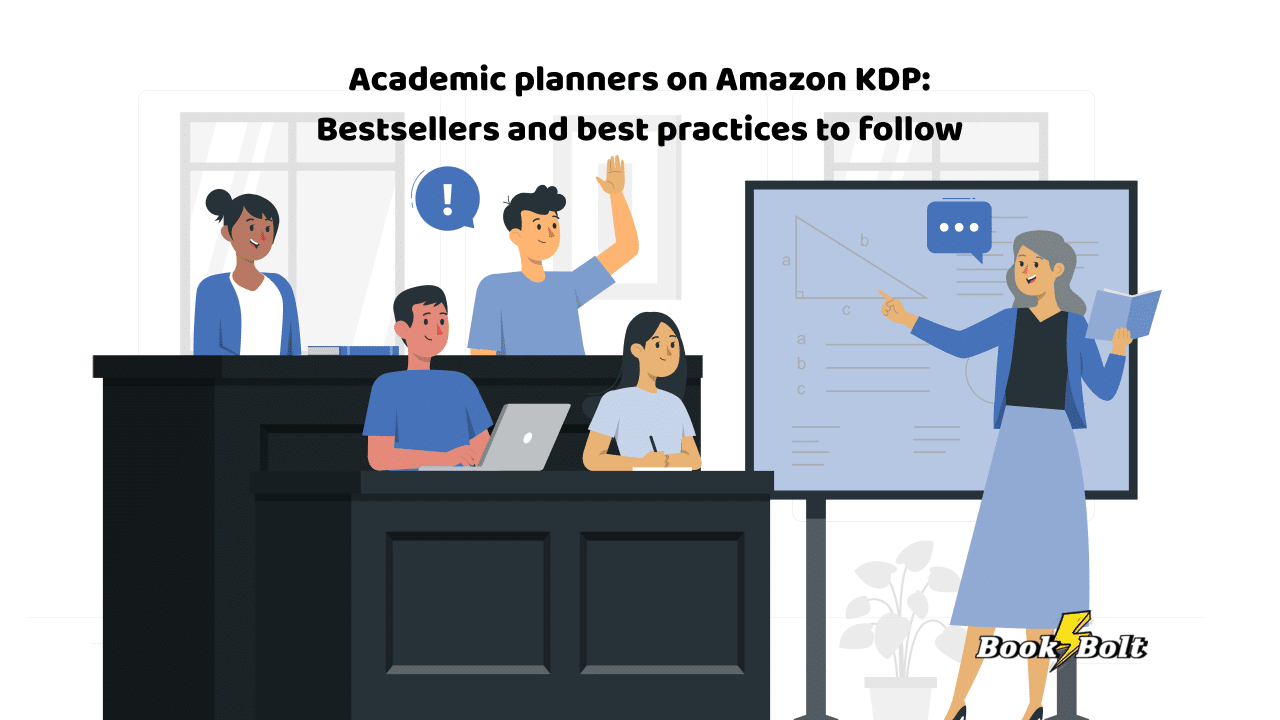
Every school student needs an academic planner to keep track of school assignments.
But the allure of this niche isn’t just about practicality. It’s about the opportunity it creates for sellers.
Whether home-schooled or classroom-taught, student demand for these no-content books is soaring on Amazon KDP.
Let’s explore the market in more depth and unveil the secrets to striking gold in this niche.
How big is the market for academic planners?
One of the first things to address when analyzing any market is its size.
We relied on Book Bolt’s Products Search module to find out how big academic planners are on Amazon KDP in terms of sales.
We typed “academic” in the module’s search box, chose the US as the marketplace, and selected planners as our category.

The tool instantly revealed that the average best-seller’s rank for these books is at an attractive low of 1,872,455. This means that the sales potential within this space is high.
But how many Amazon shoppers are searching for academic planners monthly? And how are sellers catering to this demand?
Below, we explore several metrics associated with these questions:
- Top searched-for keywords
- Search volumes
- Keyword saturation
Keywords and search volume
Using Book Bolt’s Keyword tools, we identified the following top searched-for keywords related to academic planners:
- “Academic planners”: search volume – 92,645
- “Academic planner”: search volume – 91,424
- “Academic calendar”: search volume – 5,798
- “Academic organizer”: search volume – 2,293
- “Academic journals”: search volume – 2,229
- “Academic notebook”: search volume – 2,228
- “Academic journal”: search volume – 2,186
- “Academic agenda”: search volume – 2,082
- “Academic scheduler”: search volume – 1,648
- “Academic diary”: search volume – 1,580
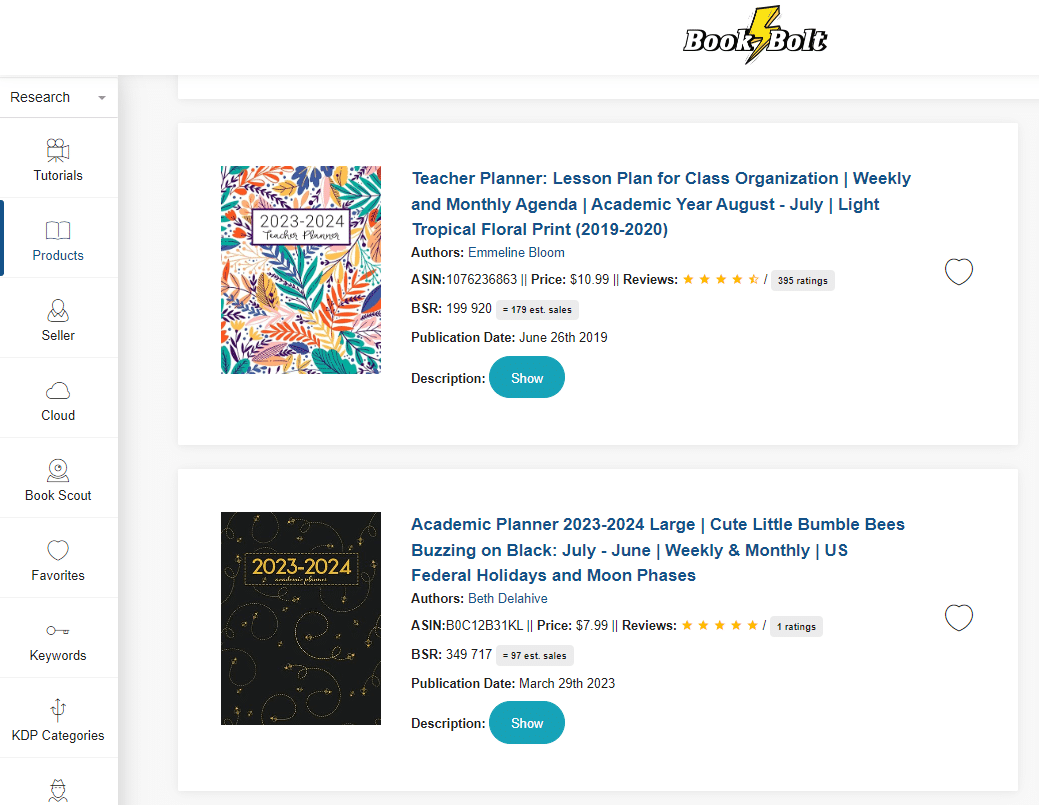
The combined monthly search volume of all phrases listed above is nearly 300,000. This means that there are plenty of opportunities for sales.
However, we noticed that shoppers aren’t just browsing for academic planners. There’s also a significant demand for other no- and low-content book categories. Examples include journals, calendars, and notebooks.
In addition, we identified diverse activity-related keywords that are also popular among consumers, like “organizer”, “agenda”, “scheduler”, and “diary”.
Regardless of the keyword variety, academic planners receive the highest search volume, making them the most lucrative option to explore.
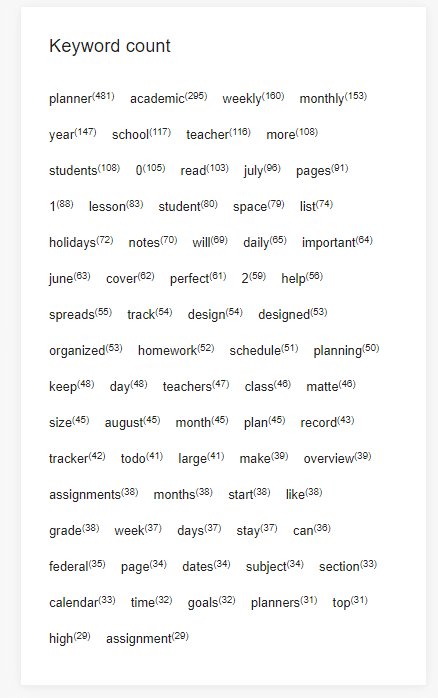
Keep reading to find out.
Keyword saturation
Keyword saturation refers to the amount of times sellers use specific phrases in listings to reach their audience.
Here are the main keywords used by merchants in their listing titles, grouped in categories:
- No- or low-content book category: planner (135), organizer (19), book (17), tracker (8), notebook (4)
- Niche: academic (106), school (35), homeschool (8), elementary (8)
- Time frame: weekly (61), monthly (52), year (49), daily (11), undated (11)
- Target audience: teacher (32), student (29), students (19)
- Purpose: planning (14), homework (12), record (12), plan (9), organization (5)
This data offers a couple of interesting insights.
First, not all book creators use the word “planner”. Some promote their products as organizers, trackers, or notebooks.
However, keep in mind that “planner” dominates the scene (as it’s used 135 times).
Second, the niche is entirely linked to education. The target audience is primarily students, even though some sellers also aim to attract teachers.
Third, the purpose of academic planners is to plan, keep records, organize, and note down homework.
Pricing
So far, we’ve laid out the foundation behind academic planners.
But how cheap or expensive are these products on Amazon KDP?
The best way to find out is by analyzing the minimum, maximum, and average prices in the market.
Using Book Bolt, we discovered the following rates:
- Lowest price: $1.47
- Highest price: $36.89
- Average price: $9.61

Based on the numbers above, it becomes clear that academic planners sell from $4.50 to $20.
But the golden middle is around the $9 mark.
Say you decide to tap into this niche and create a 100-page academic planner that costs $9. According to Amazon KDP’s royalty calculator, you’ll be earning around $3.10 per sale.
Is this good or bad?
It all depends on your monthly sales.
Below, we’ll examine the performance of some of the bestsellers to help you make accurate profit predictions.
What are some of the best-selling merchants doing right?
Now that we have a better idea about the potential of this niche, it’s time to study some of the bestsellers.
What are they doing right to earn those sales and get the right amount of visibility?
Let’s find out.
Seller 1
Title: Homeschool Mama: Daily Assignment and Record Book Planner For One Student – Academic School Year – Pretty Yellow Flowers
- Author: Emmeline Bloom
- Price: $9.99
- BSR: 404,285
- Total sales: 60
Seller 2
Title: The Bulletproof Planner: Executive Function and ADHD Academic Planner (Bulletproof Planners)
- Author: Marilyn Gannon
- Price: $9.99
- BSR: 477,183
- Total sales: 28
Keyword usage
Exploring these sellers’ keyword strategies, we made several conclusions.
The first seller targets a very specific audience – homeschool mothers.
They outline important details straight from the title. For example, they describe the planner as a daily assignment and record book for a single student to use throughout an entire academic year.
Phrases like “pretty yellow flowers” help create an image of the book’s cover design.
The second seller also uses the word planner (three times). While this repetition is not optimal, the listing appears to be generating a lot of interest. After all, this is the highest-selling book in the segment with 269 sales.
As opposed to the first example, this listing targets ADHD students.
Although this seller has mentioned the target audience and the type of book they’re offering, they haven’t fully optimized their title. Regardless, they’re still bringing home the bacon.
Let’s see what other strategies they’re using.
Pricing
As mentioned earlier, the niche’s average price stands at $9.61.
Both sellers have priced their products closely to this, at $9.99.
By adopting this pricing strategy, sellers strike a balance. They reduce the risk of alienating buyers with steep prices. At the same time, they prevent the perception that a low-cost no-content book equates to inferior quality.
Cover design
The cover designs of these two sellers differ dramatically, and for good reason.
Seller one captivates shoppers with a design featuring “pretty yellow flowers”. Meanwhile, Seller Two draws attention with a striking blue and black background showcasing a dartboard and a bullseye target.
With this in mind, we can conclude that it’s often not the design that will guide your sales.
Rather, your performance depends on a combination of factors such as your cover, pricing, and keyword usage.
What is the profitability of this niche?
We know that buyers are actively looking for academic planners.
But how profitable are sellers in this niche?
We used Amazon’s KDP royalties calculator to work out the maths.
Here’s what we found:
Seller 1
- Price: $9.99
- Royalties: $2.85
- Sales: 255
- Profitability: $726.75
Seller 2
- Price: $10.00
- Royalties: $2.09
- Sales: 269
- Profitability: $562.21
As it turns out, pricing higher doesn’t necessarily generate a higher profitability. Why?
Because your earnings depend on additional factors, like sales volumes, page length, and more.
Pricing near the average is crucial for profits. It enables sellers to position themselves competitively, attract more traffic, and land more sales.
Our recommendations
To make all of these insights useful in practice, we’ve condensed our discoveries into a few easily digestible tips.
Here are the key takeaways you need to know:
Keywords
Choosing high search volume and low competition keywords is undoubtedly a winning move.
In this niche, the keyword “academic planner”, along with its variations, is a great starting point.
However, don’t be afraid to incorporate other words and phrases into your listing title.
Don’t forget to specify who your target audience is. In this case, it can be quite extensive – from homeschooling mothers to children with ADHD.

Price
Both bestsellers we analyzed above price their listings close to the market average of $8.91.
Although there’s only a $0.01 difference between the two prices, it has created a profitability gap of $200, which is significant.
As such, the closer you price to the average (even if it’s one cent less), the better.
And if you don’t have the time to calculate the average prices of hundreds of listings, let Book Bolt be your guide.
Cover design
When crafting your book exterior, make sure you adhere to critical design elements and hierarchies with your cover.
Irrespective of your color choice or actual design, make sure it is relevant to your audience.
Both sellers in this niche have accomplished this quite well. One of the covers caters to mothers of children who are homeschooled, while the other targets (literally) students with ADHD.
Final remarks
As we wrap up, it’s clear as daylight that there is explosive potential in the academic planner niche.
However, sellers who would like to dip their fingers in the honey pot need to bear a few best practices in mind.
Throughout your journey, take advantage of Book Bolt – a platform that gives you everything you need to make a success of your passive income side gig.
At only $9.99, it’s worth less than two coffees per month. A meagre investment into something that can earn you upwards of $500.
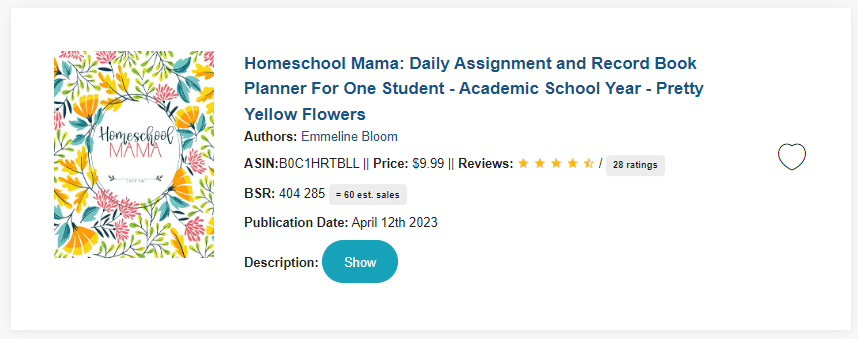 Title: Homeschool Mama: Daily Assignment and Record Book Planner For One Student – Academic School Year – Pretty Yellow Flowers
Title: Homeschool Mama: Daily Assignment and Record Book Planner For One Student – Academic School Year – Pretty Yellow Flowers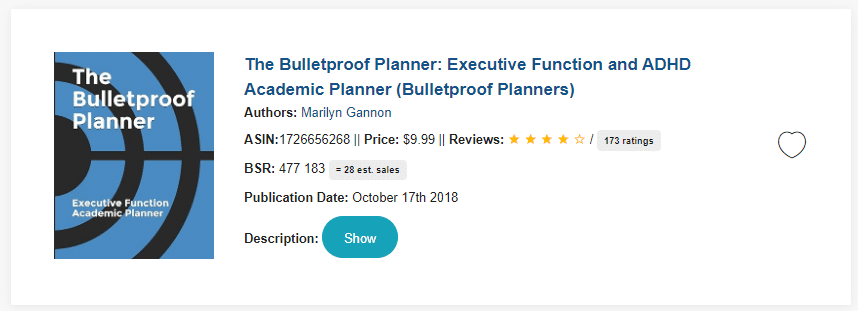 Title: The Bulletproof Planner: Executive Function and ADHD Academic Planner (Bulletproof Planners)
Title: The Bulletproof Planner: Executive Function and ADHD Academic Planner (Bulletproof Planners)